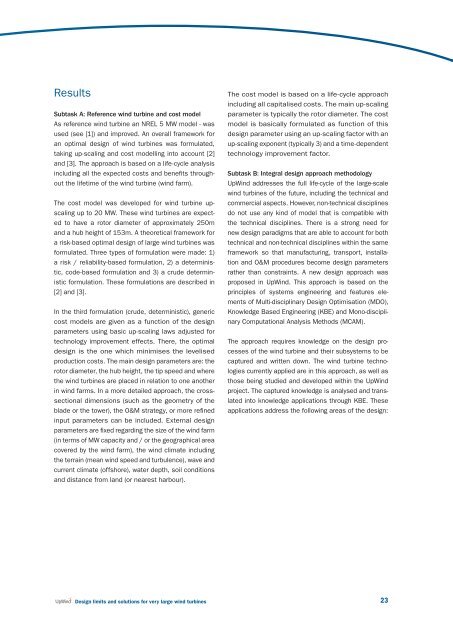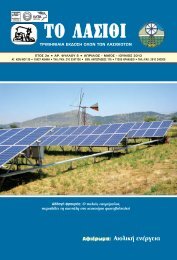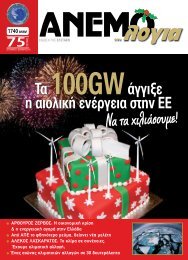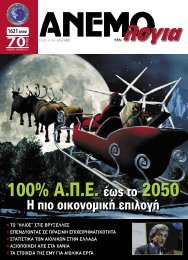Design limits and solutions for very large wind turbines
Design limits and solutions for very large wind turbines
Design limits and solutions for very large wind turbines
Create successful ePaper yourself
Turn your PDF publications into a flip-book with our unique Google optimized e-Paper software.
Results<br />
Subtask A: Reference <strong>wind</strong> turbine <strong>and</strong> cost model<br />
As reference <strong>wind</strong> turbine an NREL 5 MW model - was<br />
used (see [1]) <strong>and</strong> improved. An overall framework <strong>for</strong><br />
an optimal design of <strong>wind</strong> <strong>turbines</strong> was <strong>for</strong>mulated,<br />
taking up-scaling <strong>and</strong> cost modelling into account [2]<br />
<strong>and</strong> [3]. The approach is based on a life-cycle analysis<br />
including all the expected costs <strong>and</strong> benefi ts throughout<br />
the lifetime of the <strong>wind</strong> turbine (<strong>wind</strong> farm).<br />
The cost model was developed <strong>for</strong> <strong>wind</strong> turbine upscaling<br />
up to 20 MW. These <strong>wind</strong> <strong>turbines</strong> are expected<br />
to have a rotor diameter of approximately 250m<br />
<strong>and</strong> a hub height of 153m. A theoretical framework <strong>for</strong><br />
a risk-based optimal design of <strong>large</strong> <strong>wind</strong> <strong>turbines</strong> was<br />
<strong>for</strong>mulated. Three types of <strong>for</strong>mulation were made: 1)<br />
a risk / reliability-based <strong>for</strong>mulation, 2) a deterministic,<br />
code-based <strong>for</strong>mulation <strong>and</strong> 3) a crude deterministic<br />
<strong>for</strong>mulation. These <strong>for</strong>mulations are described in<br />
[2] <strong>and</strong> [3].<br />
In the third <strong>for</strong>mulation (crude, deterministic), generic<br />
cost models are given as a function of the design<br />
parameters using basic up-scaling laws adjusted <strong>for</strong><br />
technology improvement effects. There, the optimal<br />
design is the one which minimises the levelised<br />
production costs. The main design parameters are: the<br />
rotor diameter, the hub height, the tip speed <strong>and</strong> where<br />
the <strong>wind</strong> <strong>turbines</strong> are placed in relation to one another<br />
in <strong>wind</strong> farms. In a more detailed approach, the crosssectional<br />
dimensions (such as the geometry of the<br />
blade or the tower), the O&M strategy, or more refi ned<br />
input parameters can be included. External design<br />
parameters are fi xed regarding the size of the <strong>wind</strong> farm<br />
(in terms of MW capacity <strong>and</strong> / or the geographical area<br />
covered by the <strong>wind</strong> farm), the <strong>wind</strong> climate including<br />
the terrain (mean <strong>wind</strong> speed <strong>and</strong> turbulence), wave <strong>and</strong><br />
current climate (offshore), water depth, soil conditions<br />
<strong>and</strong> distance from l<strong>and</strong> (or nearest harbour).<br />
The cost model is based on a life-cycle approach<br />
including all capitalised costs. The main up-scaling<br />
parameter is typically the rotor diameter. The cost<br />
model is basically <strong>for</strong>mulated as function of this<br />
design parameter using an up-scaling factor with an<br />
up-scaling exponent (typically 3) <strong>and</strong> a time-dependent<br />
technology improvement factor.<br />
Subtask B: Integral design approach methodology<br />
UpWind addresses the full life-cycle of the <strong>large</strong>-scale<br />
<strong>wind</strong> <strong>turbines</strong> of the future, including the technical <strong>and</strong><br />
commercial aspects. However, non-technical disciplines<br />
do not use any kind of model that is compatible with<br />
the technical disciplines. There is a strong need <strong>for</strong><br />
new design paradigms that are able to account <strong>for</strong> both<br />
technical <strong>and</strong> non-technical disciplines within the same<br />
framework so that manufacturing, transport, installation<br />
<strong>and</strong> O&M procedures become design parameters<br />
rather than constraints. A new design approach was<br />
proposed in UpWind. This approach is based on the<br />
principles of systems engineering <strong>and</strong> features elements<br />
of Multi-disciplinary <strong>Design</strong> Optimisation (MDO),<br />
Knowledge Based Engineering (KBE) <strong>and</strong> Mono-disciplinary<br />
Computational Analysis Methods (MCAM).<br />
The approach requires knowledge on the design processes<br />
of the <strong>wind</strong> turbine <strong>and</strong> their subsystems to be<br />
captured <strong>and</strong> written down. The <strong>wind</strong> turbine technologies<br />
currently applied are in this approach, as well as<br />
those being studied <strong>and</strong> developed within the UpWind<br />
project. The captured knowledge is analysed <strong>and</strong> translated<br />
into knowledge applications through KBE. These<br />
applications address the following areas of the design:<br />
<strong>Design</strong> <strong>limits</strong> <strong>and</strong> <strong>solutions</strong> <strong>for</strong> <strong>very</strong> <strong>large</strong> <strong>wind</strong> <strong>turbines</strong><br />
23









